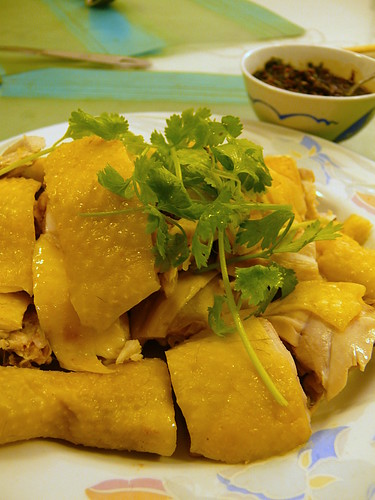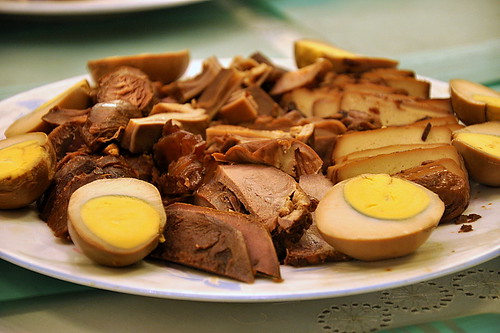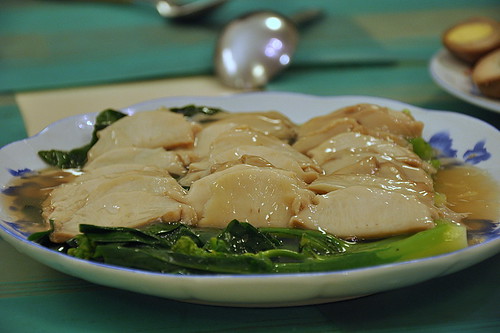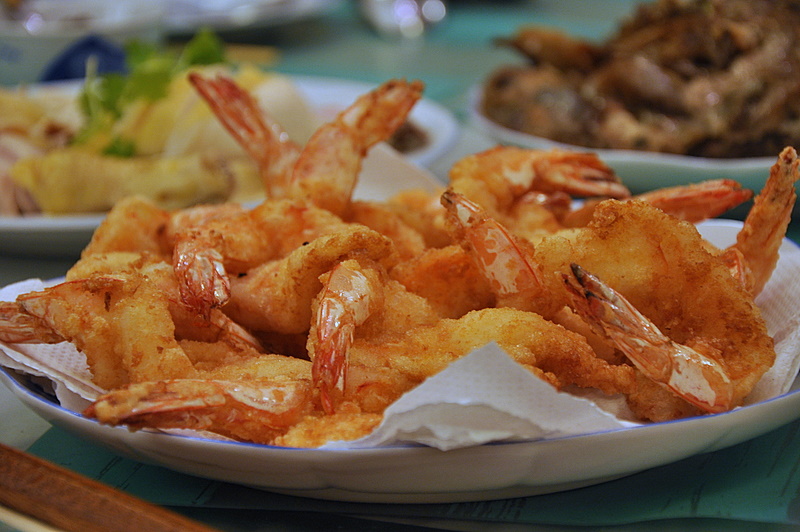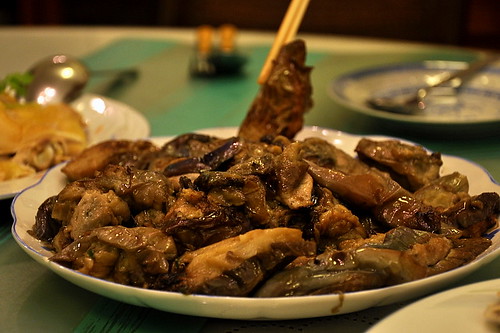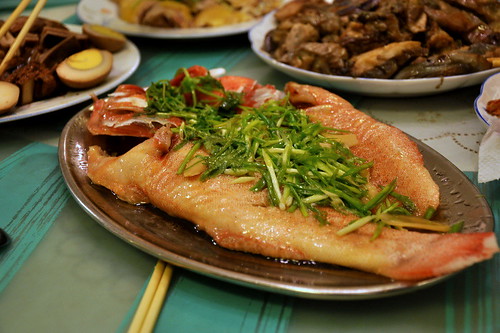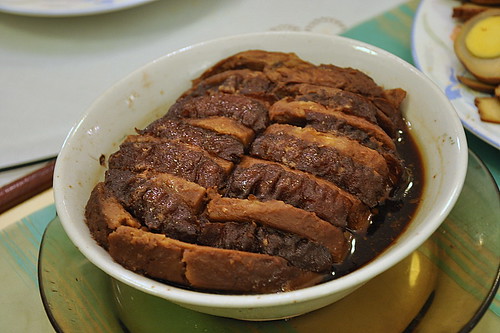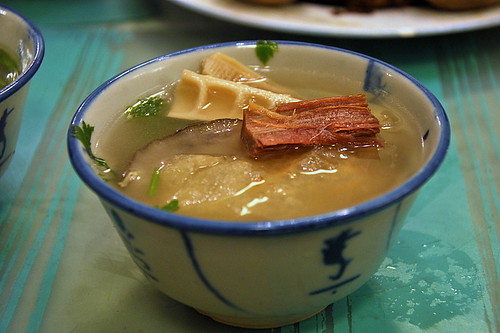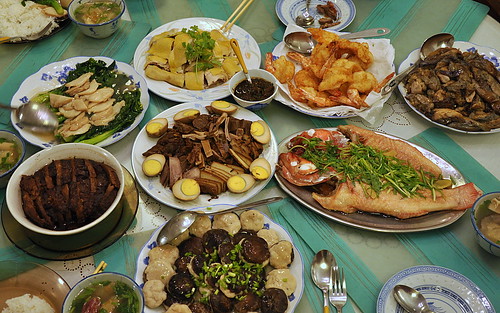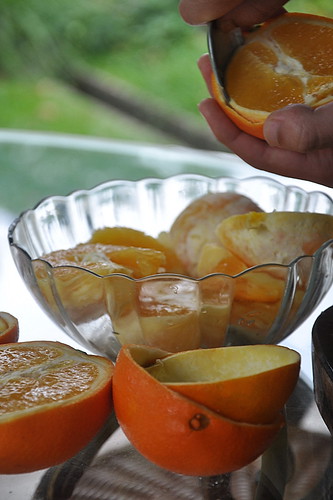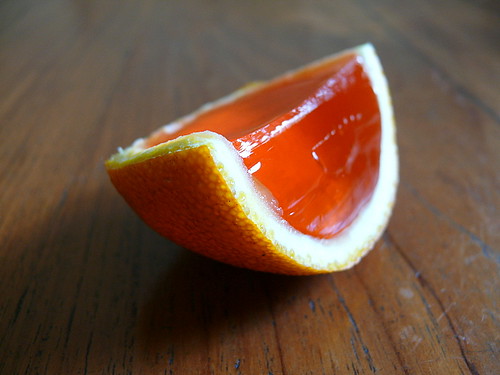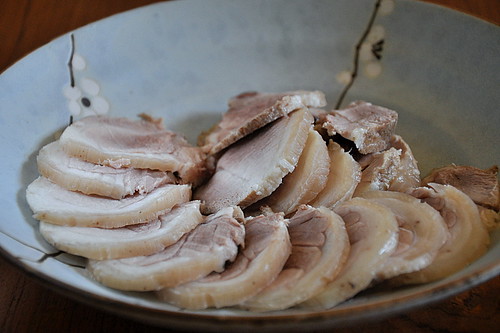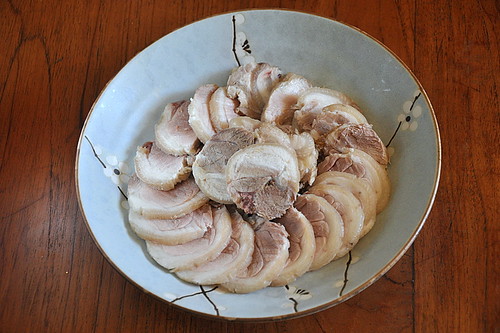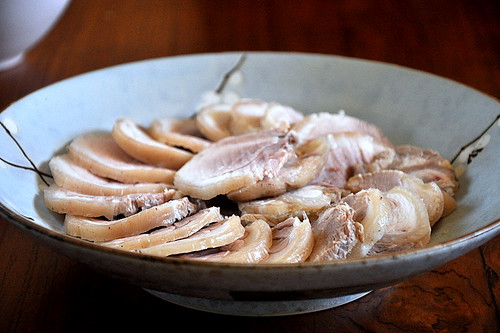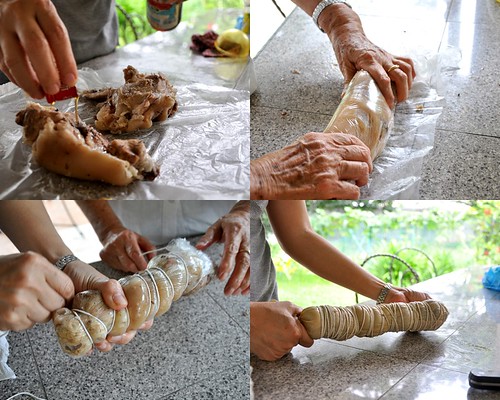This has got to be the wettest CNY ever in KK. It usually is very hot and dry during CNY, but then most CNYs fall in the month of Feb, not Jan, when it is dry. I like the rain and the coolness (around 24 C daytime) but for visitors, it is a bummer. My niece is coming for a 3-day visit from Guangzhou this weekend and the weather forecast is clouds and thunderstorms. There's nothing much in KK but nature, and with this kind of weather, you can't go to the islands, the Padas River is swollen, the fireflies don't come out and it is wet and foggy up in Kinabalu National Park. Maybe we can just stay home and play cards.
In this rain, even the lion troupes have to stay in. But we were lucky that Day 1 & 2 of CNY was cool and dry. Yesterday, the 2nd day of CNY, at least 6-8 lion dance troupes came to my area. After a while, it was a scramble to close the gate everytime we hear them coming, announced by the beating of gongs and cymbals for the unicorns, which aren't popular because they are considered weak, and drums for the lions, who are considered powerful. Then we'd scramble to duck from view so they won't keep chang-changing for us to come out if they see someone is home despite the closed gate. You see, at RM5 per red packet, I'd be giving away RM30-RM40 each day. I still let one or two dance for us because I feel sorry for the guys walking house to house in the sun in their lion suits.
Every 1st day of CNY, my kids'll (not the oldest though, she'll sleep through a volcanic eruption) only wake up when they hear the lion dance troupe. We'll hear 'dong chang dong chang', then the drummer whacks his sticks and--this part I love--the sound goes 'TAK dong chang'!
Last night, to add to the CNY mood, Yi made us all (including her 3 grandparents and uncles) watch the Chinese movie 'Ipman'. It was good, very entertaining and a feel-good movie for all Chinese. We all enjoyed it but after the end, there was a big discussion on whether the film was really anti-Japanese or pro-Japanese as the Japanese general was portrayed as a man of principals. My FIL thought it was rubbish, and against the reality of the times during the Japanese occupation in Shanghai when he had to bow and keep his head down everytime a Japanese soldier walked by. If you didn't, you'd disappear forever. If you thought some of the scenes were exaggerated and beyond reality, you should've watched the David Wang movies. Ipman was more believable than Bond too.
As I'm going to be busy the next few days, here's some pics from the 1st day of CNY in my house:
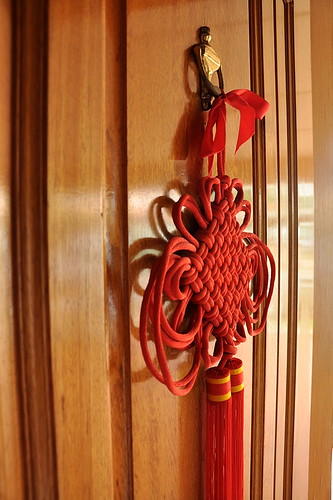
Prosperity knots on the front door
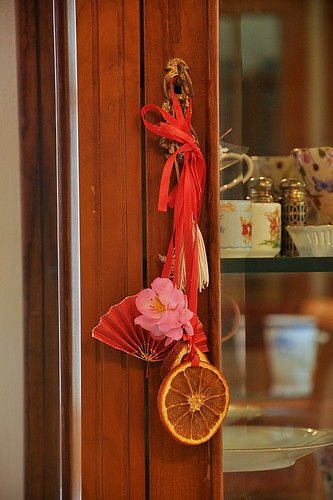
Ornament made by Yi
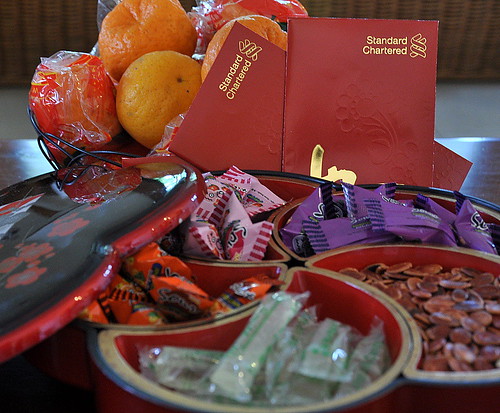
A lacquered lazy susan tray holding melon seeds, jelly and candies.
You must have a lazy susan tray, preferably a lacquer one like the one above which my MIL gave me years ago, to serve tid bits, or you've broken the tradition. In the old days, the tray would hold candied fruits but they aren't popular anymore because they are too sweet and artificially colored.

White radish gao

Indonesian lapis/layer cake
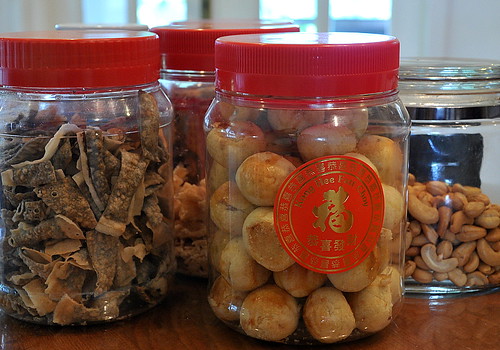
Homemade seaweed crackers, pineapple tarts and roasted cashews.
Tid bits are usually stored in plastic or glass containers that are airtight because the high humidity here turns everything soft.
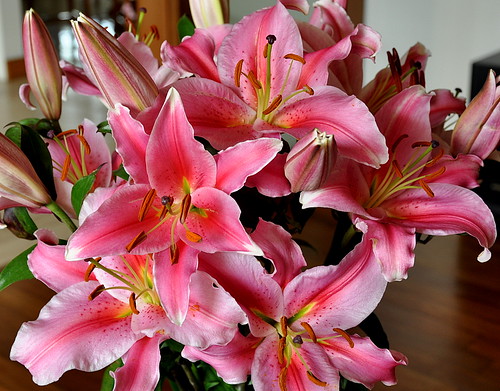
Pink tiger lilies
These are medium-sized lilies from Taiwan, a present from my MIL, and I've never seen them so fresh. They are scenting the whole house and I loathe to see them wilt.
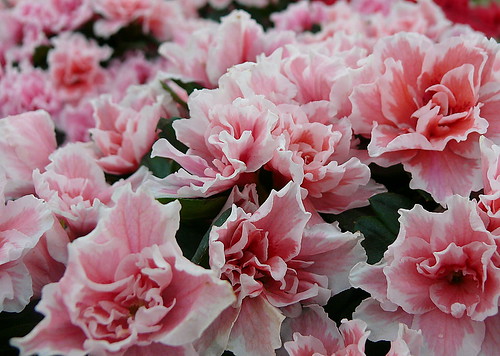

The azalea (which is quite dead by now because I forgot to water them the last 3 days) and phaleonopsis orchids are from a nursery at the foot of Mt Kinabalu.
Fresh flowers are essential for CNY because they signify spring and a new start. I make sure there's fresh cut flowers in the house for the duration of CNY.
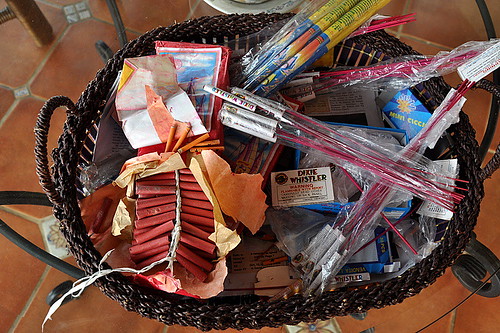
Our stash of fireworks and firecrackers, child's play compared to the big guys being lighted every night.
In this rain, even the lion troupes have to stay in. But we were lucky that Day 1 & 2 of CNY was cool and dry. Yesterday, the 2nd day of CNY, at least 6-8 lion dance troupes came to my area. After a while, it was a scramble to close the gate everytime we hear them coming, announced by the beating of gongs and cymbals for the unicorns, which aren't popular because they are considered weak, and drums for the lions, who are considered powerful. Then we'd scramble to duck from view so they won't keep chang-changing for us to come out if they see someone is home despite the closed gate. You see, at RM5 per red packet, I'd be giving away RM30-RM40 each day. I still let one or two dance for us because I feel sorry for the guys walking house to house in the sun in their lion suits.
Every 1st day of CNY, my kids'll (not the oldest though, she'll sleep through a volcanic eruption) only wake up when they hear the lion dance troupe. We'll hear 'dong chang dong chang', then the drummer whacks his sticks and--this part I love--the sound goes 'TAK dong chang'!
Last night, to add to the CNY mood, Yi made us all (including her 3 grandparents and uncles) watch the Chinese movie 'Ipman'. It was good, very entertaining and a feel-good movie for all Chinese. We all enjoyed it but after the end, there was a big discussion on whether the film was really anti-Japanese or pro-Japanese as the Japanese general was portrayed as a man of principals. My FIL thought it was rubbish, and against the reality of the times during the Japanese occupation in Shanghai when he had to bow and keep his head down everytime a Japanese soldier walked by. If you didn't, you'd disappear forever. If you thought some of the scenes were exaggerated and beyond reality, you should've watched the David Wang movies. Ipman was more believable than Bond too.
As I'm going to be busy the next few days, here's some pics from the 1st day of CNY in my house:

Prosperity knots on the front door

Ornament made by Yi

A lacquered lazy susan tray holding melon seeds, jelly and candies.
You must have a lazy susan tray, preferably a lacquer one like the one above which my MIL gave me years ago, to serve tid bits, or you've broken the tradition. In the old days, the tray would hold candied fruits but they aren't popular anymore because they are too sweet and artificially colored.

White radish gao

Indonesian lapis/layer cake

Homemade seaweed crackers, pineapple tarts and roasted cashews.
Tid bits are usually stored in plastic or glass containers that are airtight because the high humidity here turns everything soft.

Pink tiger lilies
These are medium-sized lilies from Taiwan, a present from my MIL, and I've never seen them so fresh. They are scenting the whole house and I loathe to see them wilt.


The azalea (which is quite dead by now because I forgot to water them the last 3 days) and phaleonopsis orchids are from a nursery at the foot of Mt Kinabalu.
Fresh flowers are essential for CNY because they signify spring and a new start. I make sure there's fresh cut flowers in the house for the duration of CNY.

Our stash of fireworks and firecrackers, child's play compared to the big guys being lighted every night.
The string of red fire crackers are ancient ones from MIL's house and Hub pestered her for it before she gave in on condition we don't light it because it is illegal. I used to play with fire crackers and I remember I was so daring I held the red crackers (one by one of course) in one hand and lighted it with the other instead of sticking it to the ground. Once, the cracker lit up so quickly I panicked and threw it at my sister who was standing next to me. She may have scratched me with her long fingernails, her weapons, because I don't think she'd have let me off so easily for that. I hate long pointy fingernails because of her.
Where do you find firecrackers, we wondered every year. We only discovered the open secret this year, by accident. All 'old' Chinese grocery shops have them. You just have to drop your voice and ask but do try to look like an ordinary citizen and not an undercover cop. The new crackers are like matchsticks (no more wicks or fuse), you have to strike them on a hard surface, something I now cannot muster the courage to do. Wey is enjoying himself (school's out for a week) but he said this isn't his best CNY ever because Ming's not home. Many times we missed him and said "If Ming was here, he'd..." If Ming was here, he'd play Blackjack, and not:
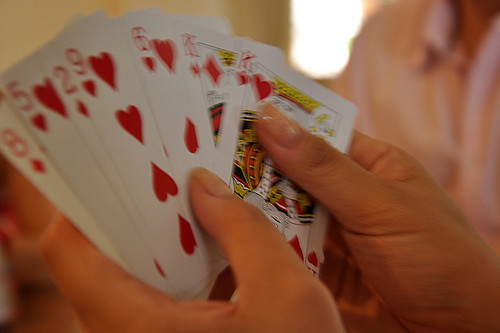
"Red Dots", a game my mother gets to play with us once a year. You should've seen how excited and happy she was.

Mandarin oranges and tangerines are must-haves during CNY because kum as they are called also sounds like the Chinese word for gold, and everybody wants prosperity, no pretense about it. But now people also wish each other "Healthy New Year/Xin Nien Jen Kang" besides "Prosperous New Year/Gong Xi Fa Cai". And the kids would always add "Hung bao na lai" (gimme the red packet) to rhyme with the greeting.

The Hakka Association lion troupe (members not in picture) was the first to come, and they asked for a drink so Yi gave them some cola and mandarin oranges and they pranced around a bit more than usual. It was funny, and a little sad, to note that all the troupe members weren't Chinese and they didn't even have the right moves for the dance. The really good lion dancers make the lions come alive, with twitching of the ear, fluttering of their eyes and scratching of the body and all kinds of movements.
If you haven't yet noticed, red is the preferred color during CNY, especially on the 1st day. The belief is that red brings good luck and drives away bad luck. Even if you don't believe it, you should wear a bit of red, or at least pink or maroon, when you visit your friends. Never wear black on CNY.

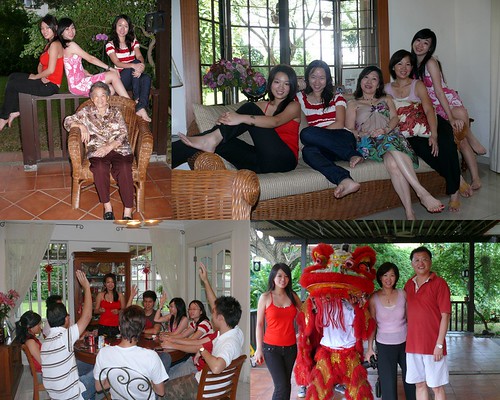
Friends and family who came to bai nien.
There's another 12 more days to celebrate CNY, so everyone, "Gong xi fa cai Xin Nien Jen Kang"!
Where do you find firecrackers, we wondered every year. We only discovered the open secret this year, by accident. All 'old' Chinese grocery shops have them. You just have to drop your voice and ask but do try to look like an ordinary citizen and not an undercover cop. The new crackers are like matchsticks (no more wicks or fuse), you have to strike them on a hard surface, something I now cannot muster the courage to do. Wey is enjoying himself (school's out for a week) but he said this isn't his best CNY ever because Ming's not home. Many times we missed him and said "If Ming was here, he'd..." If Ming was here, he'd play Blackjack, and not:

"Red Dots", a game my mother gets to play with us once a year. You should've seen how excited and happy she was.

Mandarin oranges and tangerines are must-haves during CNY because kum as they are called also sounds like the Chinese word for gold, and everybody wants prosperity, no pretense about it. But now people also wish each other "Healthy New Year/Xin Nien Jen Kang" besides "Prosperous New Year/Gong Xi Fa Cai". And the kids would always add "Hung bao na lai" (gimme the red packet) to rhyme with the greeting.

The Hakka Association lion troupe (members not in picture) was the first to come, and they asked for a drink so Yi gave them some cola and mandarin oranges and they pranced around a bit more than usual. It was funny, and a little sad, to note that all the troupe members weren't Chinese and they didn't even have the right moves for the dance. The really good lion dancers make the lions come alive, with twitching of the ear, fluttering of their eyes and scratching of the body and all kinds of movements.
If you haven't yet noticed, red is the preferred color during CNY, especially on the 1st day. The belief is that red brings good luck and drives away bad luck. Even if you don't believe it, you should wear a bit of red, or at least pink or maroon, when you visit your friends. Never wear black on CNY.


Friends and family who came to bai nien.
There's another 12 more days to celebrate CNY, so everyone, "Gong xi fa cai Xin Nien Jen Kang"!

